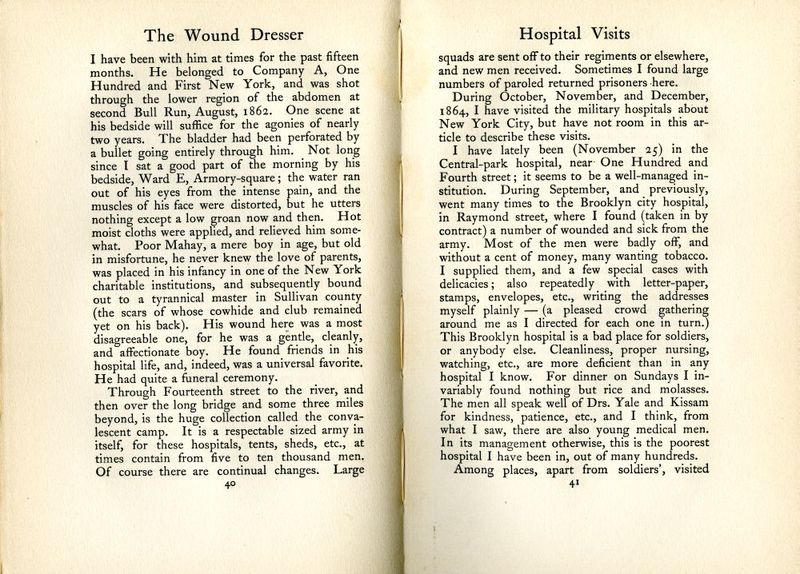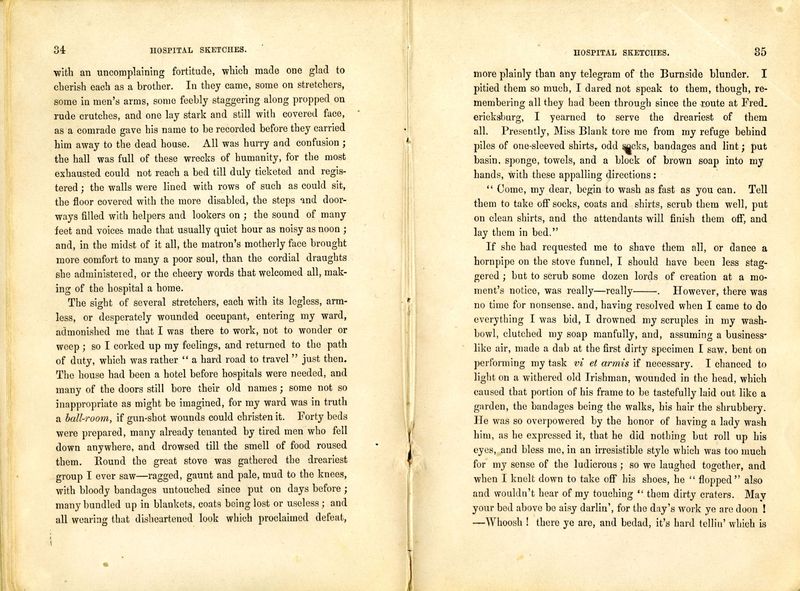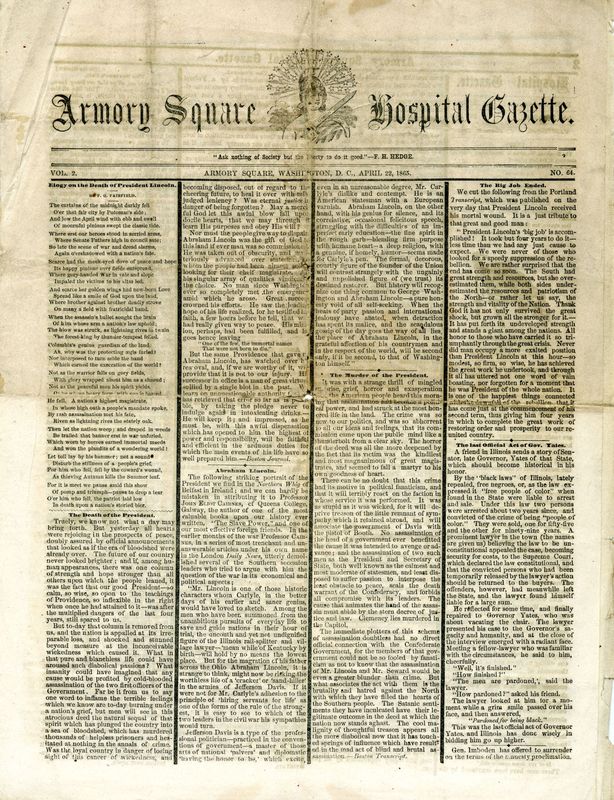2
Walt Whitman (1819-1892)
The Wound Dresser : a Series of Letters Written from the Hospitals in Washington during the War of the Rebellion, ed. by Richard Maurice Bucke
(Boston : Small, Maynard, 1898 [c1897]).
Gift of Henry Rouse Viets, M.D., to the Boston Medical Library.
Following the Battle of Fredericksburg, poet Walt Whitman went to Washington and proceeded to visit sick and wounded soldiers in the military hospitals. In a letter to his mother dated June 30, 1863, Whitman said, “I devote myself much to Armory-square hospital because it contains by far the worst cases, most repulsive wounds, has the most suffering and most need of consolation. I go every day without fail, and often at night—sometimes stay very late.” Here, in an essay contributed to the New York Times of December 11, 1864, Whitman describes the sufferings and death of an Armory Square patient, John Mahay.
Louisa May Alcott (1832-1888)
Hospital Sketches
(Boston : James Redpath, 1863).
Purchased through the Billings Fund for the Boston Medical Library, 1917.
Although literary fame came to Louisa May Alcott after the Civil War with the publication of Little women in 1868, she published this fictionalized account of nurse Tribulation Periwinkle in Hurlyburly House, based on her own experiences at the Union Hospital in Washington in 1862-1863, in issues of the Boston commonwealth, an abolitionist magazine. Alcott then revised and expanded the work into Hospital sketches. A percentage of the profits of the book were devoted to “the support of orphans made fatherless or homeless by the war.”
The Armory Square Hospital Gazette, v. 2, no. 64 (April 22, 1865).
Gift of Edmund K. Stiles to Harvard College Library and transferred to the Library of Harvard Medical School, 1988.
The Armory Square Hospital (now the site of the National Air and Space Museum) was active from August, 1862, through September, 1865, and many of the worst casualties of the battlefields were treated there. The patients and a former nurse printed and edited this weekly newspaper—the Armory Square Hospital Gazette—for the staff and patients from January, 1864, through August, 1865; the library collection holds over 30 issues of this rare publication. The issue here documents the reaction to the assassination and death of Abraham Lincoln one week earlier.
Portions of humerus removed for an ununited fracture after gunshot wound, 1862
Bone; metal wire; wood
Bone mounted and donated by Henry Jacob Bigelow, M.D., 1868
Warren Anatomical Museum, Francis A. Countway Library of Medicine [WAM 01008]
From an unidentified soldier whose arm was shattered by gunshot in mid-April 1862. Immediately after the injury fragments were removed from the arm, the ends of the fractured bone were sawed off, and fit together. After six months without union, the bones were sawed again and subsequently wired together, but without effect.
The soldier entered Massachusetts General Hospital on November 3, 1865. At that time the arm swung freely without pain. Surgeon Henry Jacob Bigelow removed three more pieces of bone with a trephine, scraped the interiors with a gouge, wired the two sections together, and splinted the arm exterior. No union occurred.
On March 1, 1866 Bigelow performed a second operation with further bone removal and wiring resulting in a stiffening of arm, but patient fell on June 10, 1866 and re-broke the humerus. On January 12, 1867 a third operation was performed with further wiring resulting in paralysis of the upper arm, although no nerve was known to be severed. This operation resulted in union of the fracture but the paralysis continued. The post-operative arm was seven inches shorter than the patient's healthy arm.
Comminuted shrapnel fracture of the ulna and comminuted gunshot fracture of the radius, 1863
Bone; brass; wood
Mounted and donated by Stephen Cushing, Harvard Medical School student, 1863
Warren Anatomical Museum, Francis A. Countway Library of Medicine [WAM 01027]
This radius and ulna was from a 35 year old soldier injured on July 3, 1863 at Gettysburg. His radius was fractured by gunshot and his ulna by a two inch long piece of fragmented gun barrel. The soft tissue of the soldier’s arm was heavily lacerated. He was removed to the military hospital at Portsmouth, Rhode Island on July 13th where the gun barrel fragment was removed. Infection set in and the arm was amputated on September 12th. A piece of the soldier’s uniform was found embedded in the flesh of the amputated limb. The soldier did well until October 4th, when he became septic. He died on October 10th.





